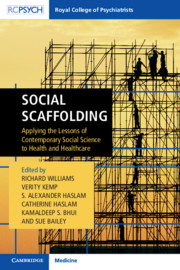Book contents
- Social Scaffolding
- Social Scaffolding
- Copyright page
- Contents
- Contributors
- Foreword
- Note
- Section 1 Schooling
- Chapter 1 Health and Society: Contributions to Improving Healthcare from the Social Sciences
- Chapter 2 Six Features of the Human Condition: The Social Causation and Social Construction of Mental Health
- Chapter 3 Social Sciences and Health: A Framework for Building and Strengthening Social Connectedness
- Chapter 4 The Social Identity Approach to Health
- Chapter 5 The Relevance of Social Science to Improving Health and Healthcare
- Section 2 Scoping
- Section 3 Sourcing
- Section 4 Scaffolding
- Section 5 Sustaining
- Index
- References
Chapter 3 - Social Sciences and Health: A Framework for Building and Strengthening Social Connectedness
from Section 1 - Schooling
Published online by Cambridge University Press: 14 June 2019
- Social Scaffolding
- Social Scaffolding
- Copyright page
- Contents
- Contributors
- Foreword
- Note
- Section 1 Schooling
- Chapter 1 Health and Society: Contributions to Improving Healthcare from the Social Sciences
- Chapter 2 Six Features of the Human Condition: The Social Causation and Social Construction of Mental Health
- Chapter 3 Social Sciences and Health: A Framework for Building and Strengthening Social Connectedness
- Chapter 4 The Social Identity Approach to Health
- Chapter 5 The Relevance of Social Science to Improving Health and Healthcare
- Section 2 Scoping
- Section 3 Sourcing
- Section 4 Scaffolding
- Section 5 Sustaining
- Index
- References
Summary
Social relationships affect health. Of that we are certain. People who are more strongly connected live longer (e.g. Holt-Lunstad et al., 2010), are in better health (e.g. Boden-Albala et al., 2005) and experience better wellbeing (e.g. Helliwell & Putnam, 2004). None of us is immune to these effects although, clearly, poverty, inequality and age, among other factors, contribute to, and exacerbate the consequences of, social disconnection.
What is more remarkable, in the context of the evidence-base showing the profound impact of these effects, is the relatively limited investment in efforts to build and preserve the social capital of vulnerable communities, on health grounds. Recognising the potential benefits that social resources bring and the mechanisms through which they can emerge is important, but not enough. What is needed is a coherent approach to embed these resources in communities to ensure that the products of social connectedness can be sustained in the longer term.
- Type
- Chapter
- Information
- Social ScaffoldingApplying the Lessons of Contemporary Social Science to Health and Healthcare, pp. 23 - 30Publisher: Cambridge University PressPrint publication year: 2019
References
- 2
- Cited by



